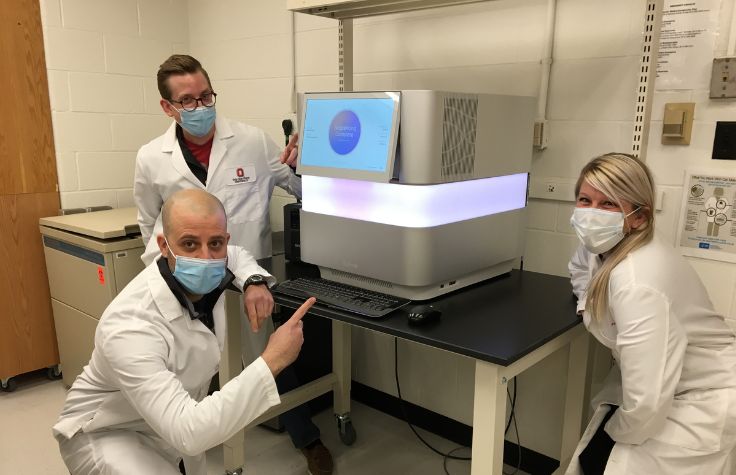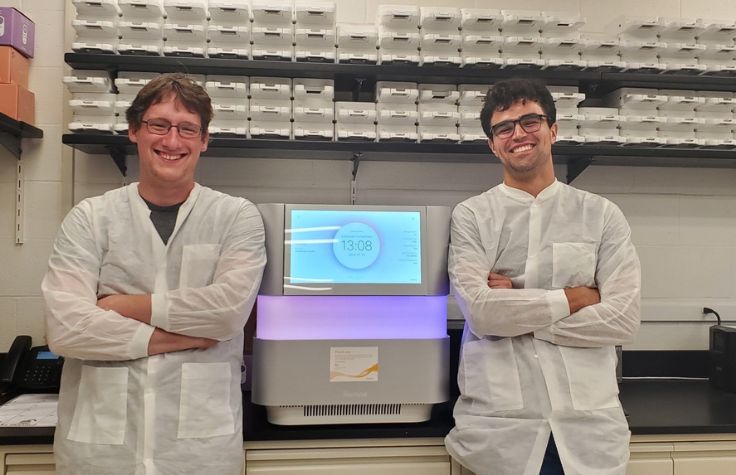
17 October 2022
When COVID-19 hit, most of The Ohio State University—home of the Buckeyes in the state capital of Columbus—shut down. But the Applied Microbiology Services Laboratory (ASML) within its Infectious Diseases Institute (IDI) stayed open.
“The Buckeyes are amazing students,” says Seth Faith, who serves as the executive director for the Center of Microbiome Science and strategic alliance officer for IDI, but also supervises the lab. “A lot of them are hungry and passionate. At least one individual working in the lab had family in Wuhan, China, and they hadn’t seen their family for two years. They wanted to be a part of solving this pandemic.”
Over the next two years or so, AMSL employed 88 lab workers at various times, who administered more than 850,000 PCR diagnostic tests for COVID-19, with an average turnaround time of 8.75 hours.
Meanwhile, an OSU professor named Karen Dannemiller had been going into homes and businesses looking for toxic chemicals in the built environment. She was also looking at microorganisms that could cause allergies or otherwise affect human health.
In the fall of 2020, Dannemiller and her team went into the isolation rooms on campus, where students who had tested positive for COVID-19 were staying for seven to 10 days. They went in on a research protocol to see if they could find coronavirus in the built environment. Indeed, through PCR testing, Dannemiller and her team found that the highest loads of coronavirus were present in the vacuum bags collected from cleaning the carpet in those rooms.
We can literally go into any room, any building, any floor, and know the specificity.
Collecting dust
Faith explains that with a respiratory virus, a person breathes out particles that will land in the space around them, not necessarily go into the HVAC system: “The biological materials have a charge associated with them and they accumulate. That’s what dust is. The virus gets entangled in this, and we can detect it with lab technology.” He reached out to Dannemiller and suggested making her experiment operational. “We optimized her protocol. We made it more sensitive. We made it more efficient, more streamlined, and then found a way to help report data.”
Each week they conducted PCR tests to measure the relative rise and fall of virus levels from dust collected on different floors of strategically chosen buildings on campus. But Faith wanted to take testing a step further. He proposed they produce the sequence information for the virus to understand not just the level of viral load but what variants were present on campus. So his genomics team modified their existing COVIDSeq protocol on their NextSeq2000s for environmental samples and produced completely resolved full SARS-CoV-2 genomes from dust. And sure enough, when levels of the omicron variant rose in their student population, they found the same pattern emerging in the dust.
“Take a building like a library that’s fourteen stories tall,” Faith explains. “Where would you expect the virus to be prevalent? Most people guess the lobby. That’s not what our data show. The lobby actually has one of the lower levels of viral load, and the highest levels are where people are spending a prolonged period of time, and probably unmasked.” They now have a lot of data taken during a time when the university required masks, and it shows that the students who got comfortable and even ate in the study areas were more likely to put the virus into the environment where the lab would detect it.
OSU has greenlighted funding for weekly sample collecting from strategic sites and laboratory processing through summer 2023. “This will help us tremendously, because all people-testing is voluntary at this point. We have this huge loss of data. We went from testing nearly 10,000 people a day to testing 10, so we don’t know the distribution on campus. That health surveillance is filling this gap.”
Faith is delighted that sequence information can be obtained through a targeted but noninvasive method. And since they’re using what’s in the waste stream, he draws a parallel with wastewater surveillance. “Vacuum cleaner bags are just going in the trash can. And now we’ve found a way to take that trash and give people public health data from it.”
Faith also plans to add influenza testing to their project scope. In 2021, Dannemiller won an NIH grant to build out coronavirus and influenza testing in Columbus elementary schools.
Among their other projects, AMSL recently received a $700,000 grant to continue sequencing wastewater samples from 60-plus wastewater treatment plants and 10 Ohio universities and submit the data to the National Wastewater Surveillance System.

Data for public health and the greater good
“With every outbreak, we’re going to need some sort of genomic technology to manage it,” Faith says. “The whole future of pathogen diagnostics is sequencing based—hands down.” He envisions a future when airports or restaurants use dust surveillance to ensure public health safety.
Meantime, Faith is excited to prepare his students for the future, and the opportunities that AMSL affords. “I’m not familiar with any students having experience using instruments worth half a million dollars or dealing with data sets that are a terabyte in size.” He plans to focus on helping students gain bioinformatics skills. “Illumina has made sequencing accessible to everyone. The first step was on the lab side—anyone can make data off a NextSeq. But now we want students to be able to analyze and report large data sets.
“Since OSU was established as an engineering and trade school, they’ve had 150 years to figure out how to train people in what was industry in Ohio. Ford and Honda both have a big presence, and our engineering college does a really great job at finding opportunities for those students to interact with and solve problems for the auto industry. But now biotech is exploding. I feel like biology is having its engineering moment.”
That’s one thing an engineer can’t tell you: if there’s a virus hovering in the Hoover, or the delta variant in the Dyson.


